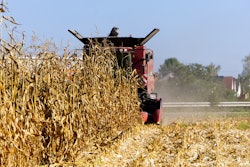
The pace and timing of the harvest, as well as the availability of grain storage, help predict grain transportation demand and shippers’ ability to weather transportation disruptions.
Snapshots of grain stocks over time and across the country help to illustrate the “when” and “where” of grain transportation demand, both for the recent past and near future.
This article uses the latest grain stocks snapshot to better understand recent grain rail carload and export numbers, as well as to illustrate potential transportation demand through the remainder of the harvest.
High Autumn Grain Supplies Boost Potential Movements in MY 2020/21
Grain available for shipping comes either from previously harvested grain held in storage or new yields from ongoing or upcoming harvests.
9月开始不w marketing year and the beginning of harvest for corn, soybeans, and grain sorghum. By September, the United States has already completed its small grains harvest (e.g., wheat, barley, and oats), so what has not already shipped is currently in the bins. Storage also contains some “old crop” corn, soybeans, and grain sorghum harvested last year.
USDA’s National Agricultural Statistics Service (NASS) offers a few snapshots of these values at different points in time.
As of September 1, 2020,NASS reportedthat farmers and commercial facilities held 7.6 billion bushels (bbu) of grain, down 8 percent from last year.
Grain stocks have been low throughout 2020.NASS also projectedfarmers would harvest 19.4 bbu of new crop corn, soybeans, and grain sorghum in marketing year (MY) 2020/21, up 11 percent from a year ago.
Over the weeks since September 1, farmers have added new corn, soybeans, and grain sorghum to storage and directly into shipping channels. Combining these two value — September 1 grain stocks and post-September 1 production — provides an indication of the total “fall grain supplies” available for transportation and use for the next several months, until new crop wheat and other small grains are added in spring 2021.
This year’s projected fall grain supplies (24.3 bbu) are 4 percent above last year and 1 percent higher than the 3-year average.
These higher levels are likely to translate into higher demand for grain transportation compared to recent years.
Grain Movements in MY 2020/21 to Date Are High, Especially for Rail
USDA projects increased use of corn, soybeans, and wheat in MY 2020/21. Domestic use and exports are each up compared to the past two years.
Most notably, exports are projected to be 24 percent higher than last year, with domestic use up 1 percent.
Based on historical modal shares, an increase in grain destinated for export would affect rail and barge shipments, and more domestic use would increase truck shipments. Exports have already seen a large uptick.
June to September grain disappearance was strong, particularly for soybeans, which was up 11 percent from the prior 3-year average.3 Soybean exports surged at the end of the summer, up 13 percent in August from the prior 3-year average.
The spike in soybean exports has continued through the week ending October 15. Mainly due to higher shipments to China, this increase suggests both the supply and demand for grain exceed those of recent years.
The rise in exports has resulted in a notable increase in grain movements, particularly for rail.
Grain carloads normally decline from late summer through early fall, until the harvest ramps up in mid-October. However, this year, carloads have trended up since late June.
Since September 1 (over the past 6 weeks), carloads have been 18 percent higher than the 3-year average. Compared to their numbers in the past few years, loaded and billed rail cars for grain have increased considerably in Nebraska, Iowa, Indiana, and Ohio.
Similarly, since September 1, barge movements of grain were 7 percent higher than the 3-year average.
Sales Respond to Accelerated MY 2020/21 Harvest and Limited Storage
As of October 18, 2020, U.S. farmers had completed 60 percent of the corn harvest, 19 percentage points (pp) more than last week.
The soybean harvest was 75 percent complete, 14 pp more than last week. The corn and soybean harvests are each 17 pp ahead of the 5-year-average schedule.
考虑到大量的粮食在存储器中相对较低ge as of September 1, this accelerated harvest may have supported the increased shipments of grain destined for export.
Looking ahead, storage availability (or lack of it) plays a key role in whether there is pressure to sell immediately during harvest. NASS provides storage and production volumes at the state level, which afford a geographic perspective on transportation demand.
在一个特定的销售年度,lesser degree, across marketing years, grain storage affects the timing of transportation demand. Where storage is abundant, it weakens harvest’s effect on the timing of transportation demand.
Conversely, in states where storage is limited relative to production, transportation demand will be more immediately tied to harvest. Significant storage deficits can require storing grain on the ground and lead to rot.
Although some of the top 15 production states have deficit storage levels, most are not projected to face significant deficits in 2020.
A few, like Nebraska and Kentucky, do have grain storage deficits that are somewhat atypical, potentially suggesting a more immediate demand for grain transportation in those states as harvest progresses. However, the deficits for other states, such as Kansas and Illinois, are not significantly unusual. Moreover, North Dakota, Iowa, and Arkansas all have atypically high storage surpluses.
Outlook
This year, total fall grain storage is less available than last year’s, but not notably scarce compared to the three-year average.
The accelerated harvest pace may have further crimped storage since September 1, raising the pressure to sell immediately.
As previously discussed, U.S. export sales and shipments over the past several weeks have already risen considerably, which may reflect an increased pressure to sell.
Outstanding export sales—which represent exports not yet shipped — remain high, which could support rail and barge movements in the near future.
Further, typical domesticuse patterns for several commodities suggest high grain transportation demand, particularly for trucking.
Corn used for ethanol generally remains stable throughout the year, while corn fed to livestock is the highest in September, October, and November.
The volume of soybeans crushed generally peaks in October, November, and December. All three — corn used for ethanol, corn used for feed, and soybeans crushed — tend to move by truck, suggesting overall demand for grain transportation could remain high for the rest of the calendar year.
For more infomation:
Information provided byUSDA Grain Transportation Report





















